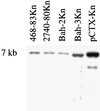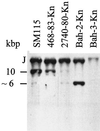Alternative mechanism of cholera toxin acquisition by Vibrio cholerae: generalized transduction of CTXPhi by bacteriophage CP-T1
- PMID: 10531246
- PMCID: PMC96972
- DOI: 10.1128/IAI.67.11.5898-5905.1999
Alternative mechanism of cholera toxin acquisition by Vibrio cholerae: generalized transduction of CTXPhi by bacteriophage CP-T1
Abstract
Horizontal transfer of genes encoding virulence factors has played a central role in the evolution of many pathogenic bacteria. The unexpected discovery that the genes encoding cholera toxin (ctxAB), the main cause of the profuse secretory diarrhea characteristic of cholera, are encoded on a novel filamentous phage named CTXPhi, has resulted in a renewed interest in the potential mechanisms of transfer of virulence genes among Vibrio cholerae. We describe here an alternative mechanism of cholera toxin gene transfer into nontoxigenic V. cholerae isolates, including strains that lack both the CTXPhi receptor, the toxin coregulated pilus (TCP), and attRS, the chromosomal attachment site for CTXPhi integration. A temperature-sensitive mutant of the V. cholerae generalized transducing bacteriophage CP-T1 (CP-T1ts) was used to transfer a genetically marked derivative of the CTX prophage into four nontoxigenic V. cholerae strains, including two V. cholerae vaccine strains. We demonstrate that CTXPhi transduced by CP-T1ts can replicate and integrate into these nontoxigenic V. cholerae strains with high efficiency. In fact, CP-T1ts transduces the CTX prophage preferentially when compared with other chromosomal markers. These results reveal a potential mechanism by which CTXPhi(+) V. cholerae strains that lack the TCP receptor may have arisen. Finally, these findings indicate an additional pathway for reversion of live-attenuated V. cholerae vaccine strains.
Figures





Similar articles
-
Analysis of clinical and environmental strains of nontoxigenic Vibrio cholerae for susceptibility to CTXPhi: molecular basis for origination of new strains with epidemic potential.Infect Immun. 1998 Dec;66(12):5819-25. doi: 10.1128/IAI.66.12.5819-5825.1998. Infect Immun. 1998. PMID: 9826360 Free PMC article.
-
CTXphi-independent production of the RS1 satellite phage by Vibrio cholerae.Proc Natl Acad Sci U S A. 2003 Feb 4;100(3):1280-5. doi: 10.1073/pnas.0237385100. Epub 2003 Jan 14. Proc Natl Acad Sci U S A. 2003. PMID: 12529504 Free PMC article.
-
Lysogenic conversion of environmental Vibrio mimicus strains by CTXPhi.Infect Immun. 1999 Nov;67(11):5723-9. doi: 10.1128/IAI.67.11.5723-5729.1999. Infect Immun. 1999. PMID: 10531221 Free PMC article.
-
Phage-bacterial interactions in the evolution of toxigenic Vibrio cholerae.Virulence. 2012 Nov 15;3(7):556-65. doi: 10.4161/viru.22351. Epub 2012 Oct 17. Virulence. 2012. PMID: 23076327 Free PMC article. Review.
-
Filamentous phages linked to virulence of Vibrio cholerae.Curr Opin Microbiol. 2003 Feb;6(1):35-42. doi: 10.1016/s1369-5274(02)00005-x. Curr Opin Microbiol. 2003. PMID: 12615217 Review.
Cited by
-
Novel type of specialized transduction for CTX phi or its satellite phage RS1 mediated by filamentous phage VGJ phi in Vibrio cholerae.J Bacteriol. 2003 Dec;185(24):7231-40. doi: 10.1128/JB.185.24.7231-7240.2003. J Bacteriol. 2003. PMID: 14645284 Free PMC article.
-
Evidence for the emergence of non-O1 and non-O139 Vibrio cholerae strains with pathogenic potential by exchange of O-antigen biosynthesis regions.Infect Immun. 2002 May;70(5):2441-53. doi: 10.1128/IAI.70.5.2441-2453.2002. Infect Immun. 2002. PMID: 11953381 Free PMC article.
-
Efficiency and specificity of CTXphi chromosomal integration: dif makes all the difference.Proc Natl Acad Sci U S A. 2010 Mar 2;107(9):3951-2. doi: 10.1073/pnas.1000310107. Proc Natl Acad Sci U S A. 2010. PMID: 20197438 Free PMC article. No abstract available.
-
Bacteriophages and genetic mobilization in sewage and faecally polluted environments.Microb Biotechnol. 2011 Nov;4(6):725-34. doi: 10.1111/j.1751-7915.2011.00264.x. Epub 2011 Apr 27. Microb Biotechnol. 2011. PMID: 21535427 Free PMC article. Review.
-
Transduction-mediated transfer of unmarked deletion and point mutations through use of counterselectable suicide vectors.J Bacteriol. 2002 Jan;184(1):307-12. doi: 10.1128/JB.184.1.307-312.2002. J Bacteriol. 2002. PMID: 11741872 Free PMC article.
References
-
- Albert M J, Siddique A K, Islam M S, Faruque A S, Ansaruzzaman M, Faruque S M, Sack R B. Large outbreak of clinical cholera due to Vibrio cholerae non-O1 in Bangladesh. Lancet. 1993;341:704. - PubMed
-
- Berche P, Poyart C, Abachin E, Lelievre H, Vandepitte J, Dodin A, Fournier J M. The novel epidemic strain O139 is closely related to the pandemic strain O1 of Vibrio cholerae. J Infect Dis. 1994;170:701–704. - PubMed
Publication types
MeSH terms
Substances
Grants and funding
LinkOut - more resources
Full Text Sources
Miscellaneous

